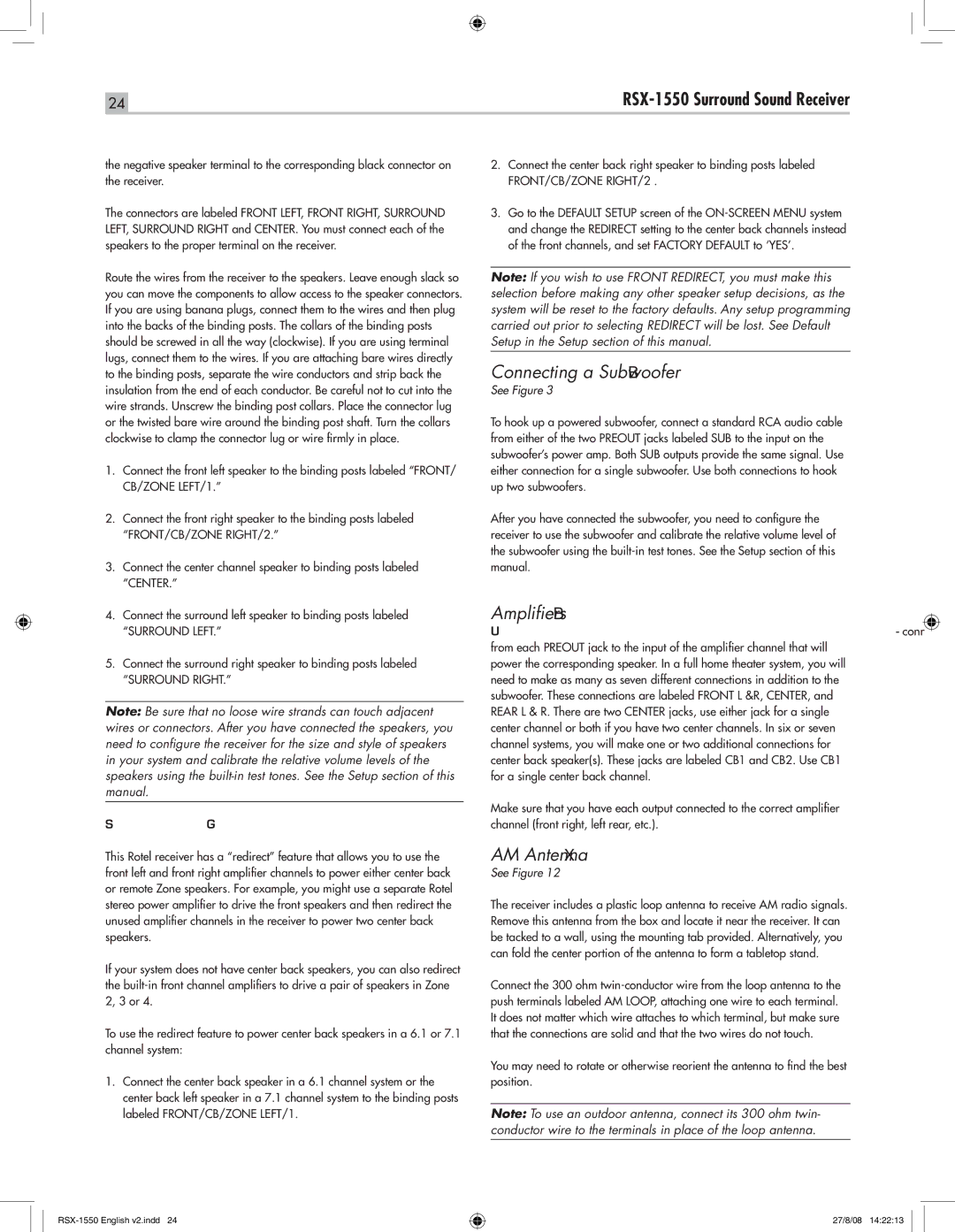
24 |
|
the negative speaker terminal to the corresponding black connector on the receiver.
The connectors are labeled FRONT LEFT, FRONT RIGHT, SURROUND LEFT, SURROUND RIGHT and CENTER. You must connect each of the speakers to the proper terminal on the receiver.
Route the wires from the receiver to the speakers. Leave enough slack so you can move the components to allow access to the speaker connectors. If you are using banana plugs, connect them to the wires and then plug into the backs of the binding posts. The collars of the binding posts should be screwed in all the way (clockwise). If you are using terminal lugs, connect them to the wires. If you are attaching bare wires directly to the binding posts, separate the wire conductors and strip back the insulation from the end of each conductor. Be careful not to cut into the wire strands. Unscrew the binding post collars. Place the connector lug or the twisted bare wire around the binding post shaft. Turn the collars clockwise to clamp the connector lug or wire firmly in place.
1.Connect the front left speaker to the binding posts labeled “FRONT/ CB/ZONE LEFT/1.”
2.Connect the front right speaker to the binding posts labeled “FRONT/CB/ZONE RIGHT/2.”
3.Connect the center channel speaker to binding posts labeled “CENTER.”
4.Connect the surround left speaker to binding posts labeled “SURROUND LEFT.”
5.Connect the surround right speaker to binding posts labeled
“SURROUND RIGHT.”
Note: Be sure that no loose wire strands can touch adjacent wires or connectors. After you have connected the speakers, you need to configure the receiver for the size and style of speakers in your system and calibrate the relative volume levels of the speakers using the
Redirect Feature
This Rotel receiver has a “redirect” feature that allows you to use the front left and front right amplifier channels to power either center back or remote Zone speakers. For example, you might use a separate Rotel stereo power amplifier to drive the front speakers and then redirect the unused amplifier channels in the receiver to power two center back speakers.
If your system does not have center back speakers, you can also redirect the
To use the redirect feature to power center back speakers in a 6.1 or 7.1 channel system:
1.Connect the center back speaker in a 6.1 channel system or the center back left speaker in a 7.1 channel system to the binding posts labeled FRONT/CB/ZONE LEFT/1.
2.Connect the center back right speaker to binding posts labeled FRONT/CB/ZONE RIGHT/2 .
3.Go to the DEFAULT SETUP screen of the
Note: If you wish to use FRONT REDIRECT, you must make this selection before making any other speaker setup decisions, as the system will be reset to the factory defaults. Any setup programming carried out prior to selecting REDIRECT will be lost. See Default Setup in the Setup section of this manual.
Connecting a Subwoofer c
See Figure 3
To hook up a powered subwoofer, connect a standard RCA audio cable from either of the two PREOUT jacks labeled SUB to the input on the subwoofer’s power amp. Both SUB outputs provide the same signal. Use either connection for a single subwoofer. Use both connections to hook up two subwoofers.
After you have connected the subwoofer, you need to configure the receiver to use the subwoofer and calibrate the relative volume level of the subwoofer using the
Amplifiers c
To hook up optional power amplifiers, connect an audio cable from each PREOUT jack to the input of the amplifier channel that will power the corresponding speaker. In a full home theater system, you will need to make as many as seven different connections in addition to the subwoofer. These connections are labeled FRONT L &R, CENTER, and REAR L & R. There are two CENTER jacks, use either jack for a single center channel or both if you have two center channels. In six or seven channel systems, you will make one or two additional connections for center back speaker(s). These jacks are labeled CB1 and CB2. Use CB1 for a single center back channel.
Make sure that you have each output connected to the correct amplifier channel (front right, left rear, etc.).
AM Antenna y
See Figure 12
The receiver includes a plastic loop antenna to receive AM radio signals. Remove this antenna from the box and locate it near the receiver. It can be tacked to a wall, using the mounting tab provided. Alternatively, you can fold the center portion of the antenna to form a tabletop stand.
Connect the 300 ohm
You may need to rotate or otherwise reorient the antenna to find the best position.
Note: To use an outdoor antenna, connect its 300 ohm twin- conductor wire to the terminals in place of the loop antenna.
27/8/08 14:22:13
